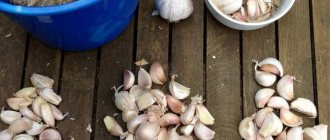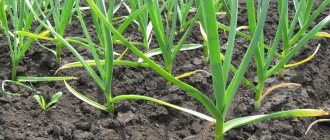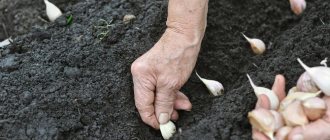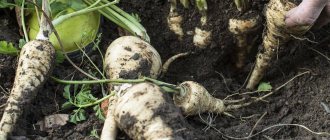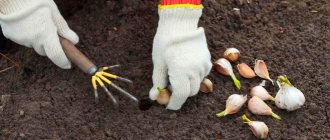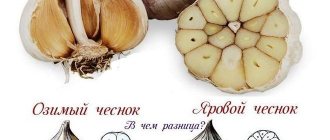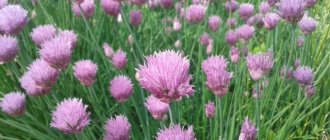Spring and winter garlic - how are they similar and how are they different? Everyone knows that garlic comes in winter and spring, but not every novice gardener can distinguish between these two crops. And it is necessary to know the differences so as not to make a mistake with the planting time: winter garlic is planted before winter, and spring garlic - in the spring. Read the article about the difference between spring garlic and winter garlic, and what will happen if you plant winter garlic in the spring.
Recommendations for planting
Spring garlic, as mentioned above, is planted in the spring.
The optimal period is the end of March - beginning of April. Planting is carried out as soon as the snow and water disappear from the beds, and the temperature is established at a level not lower than plus 5 degrees. The main condition is that the soil is saturated with moisture; if there is not enough of it, garlic will grow with a lower yield. For planted spring varieties, hot weather is destructive, for this reason it is important to plant in spring as early as possible
Planting winter garlic in the spring allows you to get high-quality and tasty greens.
Winter garlic is planted in the fall, 15-20 days before the onset of stable weather with low temperatures and frosts. This period occurs at the beginning - mid-October. It all depends on the specific variety and climate characteristics in the region.
General landing requirements
- The depth of placement of cloves in the soil is 5-7 cm for winter crops, 3-5 cm for spring crops. Greater depth is important in the fall so that the soil layer provides additional protection in the winter.
- The shallow depth in spring allows spring varieties to germinate quickly while the weather is moderate.
- Planting is done in rows.
- The distance between rows is 15-20 cm.
- The distance between plants in a row is 10-15 cm. The exact parameters depend on the size of the planting material.
Planting scheme for spring and winter garlic
It is important to change areas and beds for planting garlic. It is best to alternate planting them with legumes, cucumbers, cabbage
It is not recommended to alternate with onions and potatoes. After using the soil for garlic, it needs to be given a “rest” from this plant for at least 3 years.
The yield of spring garlic is affected by the nature of winter storage. If the bulbs were stored in a warm room where the average temperature was 18 degrees, the garlic will grow large, but its ripening time will be extended. Storing in a cooler place (most often a balcony or basement is used), at an average temperature of plus 5 degrees, the plant will produce smaller bulbs, but the growing season will be shorter, and the harvest will ripen earlier. Experienced gardeners recommend storing garlic in a warm place after harvesting, and 30 days before planting, that is, in February, transferring it to a cooler place for storage.
Shoots of winter garlic in spring
A mandatory requirement for planting is mulching and loosening the soil. These measures will preserve moisture and oxygen in the soil and protect it from compaction. The following are used as mulch: peat, sawdust, hay, straw. Mulch layer – 2-5 cm.
Cleaning tips
To harvest a high-quality harvest of spring or winter garlic, it is necessary to harvest on time, following several rules for preparing for storage.
Straightening the arrows - the garlic is ripe
- The ripeness of winter garlic is determined using arrows. As they grow, they twist and twist. As soon as the arrows become straight, you need to prepare for harvesting - the garlic is ripe.
- In spring garlic, due to the absence of arrows, ripeness is determined using the leaves. If the leaves of the lower tier begin to dry out and “fit” to the soil, and the upper ones turn yellow, you can begin harvesting.
- Cleaning is carried out in dry and sunny weather.
- It is more convenient to use small forks for digging.
Drying the crop before storage
You need to dry the garlic in a well-ventilated place. In practice, dirt-free garlic is dried directly on the beds. The main thing is not to get caught in the rain or strong sun. For this reason, it is better to prepare a special place with a canopy. Drying time is 10-15 days.
Storing garlic in nets
After drying, you need to sort out the garlic, discard diseased and rotten bulbs, and select planting material for the next season. When sorting, you need to group, dividing the harvest into groups: large, medium and small bulbs. For storage, you can use mesh bags, cardboard boxes, wooden boxes, special plastic pallets, etc.
The post What are the differences between spring and winter garlic appeared first SeloMoe.
Cleaning and storage
Storing spring garlic
You can determine when the harvest can be harvested when the leaves turn yellow and gradually begin to dry out - this is the first sign that the spring garlic crop is ready for harvest. Cleaning is carried out in dry weather, until the second half of September. The plant should lie on the ground for the first hour, then dry it under a canopy, provided that the temperature is warm. You can do this in the attic. During this time, the heads fully ripen. If the garlic heads are exposed to the scorching sun, this will significantly reduce the storage time.
Plants can be laid out in an even layer on a surface or grid. They can also be tied into medium-sized buns and hung. It is important that there are no damage, dents or scratches on the bulbs, otherwise various kinds of microorganisms can penetrate there, which will result in a shorter shelf life.
Storing spring garlic
Braided garlic is best stored on the wall. To do this, it is recommended to use paper or cardboard bags with air access. The bags are stored in a cool, dry place. This is a warm storage method. Dried leaves should be cut to 5 cm from the neck of the head. Cutting too short can damage the bulb. In cold conditions, garlic bulbs are placed in a dry room or refrigerator with a temperature of +1 to +5 degrees.
Storage of winter crops
In order for the winter species to have a long shelf life, it is not recommended to grow it in damp places and liberally apply nitrogen-containing fertilizers to the soil. When the bulbs are ready for harvesting, do not water the soil for three weeks.
Only the best heads of garlic are selected for storage; they should not be damaged, and they should have 3 hard scales that will cover the entire bulb.
Next, the garlic bulbs are sent to dry for about 28 days. They are cleaned, contaminated scales are removed, and trimmed if necessary. If there is a need to remove the roots, they are plucked out or burned over a gas stove, leaving only the bottom.
To preserve the harvest longer in the apartment, it is recommended to treat it with boiled vegetable oil, adding a few drops of iodine. Then dry in the open air.
It can also be stored in the pantry or refrigerator. But it is important to remember that it is recommended to use winter garlic first, since it has a certain shelf life, and it is lower than that of spring garlic.
An excellent way to store crops can be special nets or canvas bags. To prevent the bulbs from losing their moisture, they are sprinkled with onion peels.
Concluding whether spring or winter garlic is better stored, based on the above facts, the storage of winter crops is lower than spring garlic.
Therefore, taking into account all the factors when planting and storing garlic, in the future you will be able to enjoy dishes and preparations that include this delicious garlic crop.
How to distinguish winter garlic from spring garlic and which is best stored?
Gardening specialists know what spring and winter garlic are, what their differences are, and which one stores better. For those who are faced with cultivation for the first time, it is difficult to understand all the issues. This article will help them.
To reap a good harvest, you need to carefully study the peculiarities of growing this crop. When it comes to garlic, the gardener needs knowledge of how to distinguish the winter variety from the spring variety. Untimely planted spring and winter garlic will not produce a harvest.
Based on these differences, even an inexperienced gardener can easily determine the type of garlic and, accordingly, plant it correctly and grow a good harvest. Therefore, the first thing you need to do is learn to distinguish between them:
- The winter species is formed from large cloves that are evenly spaced around the arrow stem. They are all similar in shape and size;
- winter crops have few cloves, their number is always even;
- spring has many cloves in the head. Their number can be from 12 to 20. All of them can be of different sizes and shapes;
- winter has a harder thick stump;
- Winter garlic usually has a flower shoot;
- The spring tree has no frog and has a thin soft stump.
Lovers of greenery can safely plant winter garlic for this purpose in the spring. In addition, due to the fact that winters in Russia are very harsh, a spring species planted for the winter may freeze.
When planting this crop, you cannot plant it in the same place every year, since the soil may contain harmful bacteria and pests. It is good to plant it after early harvested crops:
- legumes;
- cabbage;
- cucumbers;
- radish.
Also, when planting, it is necessary to maintain the distance between the cloves, it should be 10 centimeters, the distance between the beds should be about 5 centimeters. Humus or compost, applied to the soil in a timely manner, will significantly increase productivity.
Spring garlic
This question can be answered like this. It is necessary to plant both types of garlic - winter and spring. If suddenly the winter crop does not produce a harvest, then the spring crop will compensate for it, and vice versa.
Since winter garlic ripens earlier (by the end of July - beginning of August), it can be used in the earliest homemade preparations.
But despite the early ripening and higher yield of winter garlic, it is stored without deterioration in quality for 5 - 7 months, and spring garlic - until a new harvest.
I hope the article was useful to you!
If you plan to plant a vegetable in order to store the harvested crop in the cellar in winter, it is better to give preference to spring garlic. This species stores much better in almost any conditions.
To create winter preserves, gardeners are advised to choose winter, as its fruits have a rich taste. This variety is also more productive, so it is enough to create a large number of preparations for the winter.
Many gardeners who grow garlic on their plots do not know which type of vegetable is best stored in winter. For winter storage, it is better to grow spring bushes, as their fruits have better shelf life. Winter crops are not suitable for storage in winter, since due to low temperatures they quickly lose moisture and begin to deteriorate. This happens due to the fact that such bulbs are poorly protected from the effects of temperature.
Tags: winter, summer, difference, garlic About the author: admin4ik
Winter and spring garlic: characteristics of the species
Planting time, shape and structure of the bulbs, keeping quality - these are the characteristics that allow garlic to be classified as spring or winter. It is not difficult for an experienced gardener to distinguish them.
External difference between winter and spring garlic
Varieties that are planted before winter are called winter varieties. A feature that helps distinguish them from other species is the rod in the center of the bulb, around which the cloves are placed, and their number reaches up to 20 pieces. The bottom is more powerful and strong, the scales are very dense.
Winter garlic
Spring garlic is planted in the spring. It does not have a rod, the teeth are scattered and small in size. The scales are very delicate and thin, and the bottom is not as massive as that of the winter variety.
Spring garlic
External differences are related to the planting method, because a winter seedling will lie in the soil for the whole winter, it needs reliable protection and support.
Difference in taste and beneficial components
Winter garlic is loved for its pungency and size. It is much easier to peel one large clove than five small ones. Spring varieties are characterized by small teeth and a milder taste.
The fruit of any variety invariably has a pungent taste, sometimes burning. The aroma is always very strong and special: all thanks to allicin - it is very volatile.
Interesting fact! The diet of the Spaniards, Chinese, and Koreans includes about 10 cloves daily for each resident of the country.
A head of garlic is a storehouse of useful substances, namely:
- vitamins C, PP, B1, B2, B5, B6, B9;
- carotenes;
- essential oils;
- iron, calcium, magnesium, phosphorus, potassium, sodium, zinc;
- especially deficient microelements selenium and manganese.
How to distinguish spring garlic from winter garlic by appearance
Now let's move on to finding the difference between spring and winter garlic. In fact, everything is simple, and after reading you will no longer confuse these two types.
One of the most characteristic differences lies in the appearance and shape of the garlic head. The winter head has a small number of teeth and is always even - four, six or eight. They are large and almost identical in size. But for spring garlic, the number of cloves can vary from 12 to 20, all of them are of different sizes and arranged in a spiral, the closer to the center, the smaller.
A head of spring garlic contains many cloves of varying sizes.
Another difference is in the stem, which in the winter form is easy to find in the center of the head, separating the teeth. The spring form does not have this stem.
Winter garlic has even, large cloves located around the stem
Distinctive features
How to distinguish winter garlic from spring garlic? The winter bulb is covered with hard, dense scales, and in its center there is a thick, hard core. This onion has a small number of cloves, from 6 to 10. The teeth are even, large, and there is always an even number of them. In summer varieties, the scales are soft and thin, like tissue paper, the middle shaft is soft or absent, and many small teeth of uneven shape are located chaotically.
You can distinguish spring garlic from winter garlic by the fact that shoots are formed only in winter varieties, and spring varieties, with the exception of the “Gulliver” variety, do not shoot shoots. Consequently, winter varieties can be grown using seeds that ripen in bulbs at the ends of the arrows, but summer varieties cannot.
The best winter varieties
Garlic "Alekseevsky"
Top 3 best winter crops:
- Alekseevsky. One of the most popular winter varieties is also called Alekseevsky giant. The weight of one head reaches 200 g, the husk is white. The head contains 4-6 large, even teeth. The smell is pungent, the taste is spicy-sweet, piquant. Resistant to diseases.
- Lyubasha. Weight - about 150 g, the husk is white and pink. It is characterized by high productivity and tolerates both high humidity and prolonged drought. Widely distributed in central Russia. Does not require special care.
- Titanium. The variety ripens within approximately 110 days after the appearance of the first shoots. The height of the plant is about 35 cm, the heads are large, weigh about 150 g, each with 4-6 cloves. The head is round with purple-white scales. Titanium is perfectly stored for six months and does not lose its beneficial properties.
Garlic is used in cooking, as a medicine, and even in cosmetology. Both spring and winter varieties are rich in a huge amount of vitamins and microelements - thiamine, fiber, essential oils, keratin, vegetable protein.
Before choosing a variety, carefully study its characteristics and properties. Varieties differ in terms of planting, appearance, and taste. For some regions, spring varieties are better suited, for others - winter varieties.
Spring bolting garlic. Garlic: non-shooting varieties (features and differences)
Being an annual, vegetatively propagated plant of the onion family, garlic is divided into 2 subspecies - winter and spring. It is believed that this division is due to two different places of its origin: winter forms belong to the Central Asian region, and spring forms belong to the Mediterranean region. The stem, roots and leaves of garlic die in the fall of the year of planting. There are two known morphological subspecies of garlic: bolting and non-shooting.
All varieties of garlic are divided into 3 types: winter non-shooting, winter shooting and spring, which are mostly non-shooting. Some spring varieties of garlic, so-called “two-handed” in common parlance, for example, Ukrainian white Guulapolsky, Saki, Odessky 13, can be grown during winter planting, since they are capable of developing both spring and winter type, and this property is inherent in plant at the genetic level.
It should be taken into account that when planting non-shooting spring varieties of garlic before winter, the cloves must take root fully, but not grow above the soil surface. If greenery does appear in late autumn, then the plantings are covered with a thick layer of mulch, which is used as straw, peat, humus, fallen leaves and other organic material suitable for these purposes, and after the first snowfall, the beds are covered with a thick layer of snow on top. Plantings of winter garlic are covered only in severe winter conditions with persistent frosts above 15°C - this protects the plants from freezing.
It should be noted that among the non-shooting varieties of garlic there are both spring and winter varieties, as well as “two-handed” varieties. Shooting varieties of garlic are only available in winter. One of the advantages of growing non-shooting varieties of garlic is that there is no need to break out the shoots in the summer.
In non-shooting varieties of garlic, the formation of bulbs occurs within 35-50 days, which is on average 15 days longer than the formation of cloves in shooting varieties. That is why the ripening time for non-shooting varieties is 14-20 days longer. Early-ripening varieties of non-shooting garlic have a growing season of 95-105 days, mid-ripening - 105-115 and late-ripening - 115-135.
Throughout the entire growing season, the rosette of leaves of non-shooting garlic only increases significantly in size without changing its configuration or shape. Since non-shooting garlic does not shoot out arrows and, accordingly, aerial bulbs do not form, its propagation is possible only with the help of bulb cloves. The teeth of non-shooting varieties are arranged in several circles, the inner layer containing smaller specimens. For seed purposes, the cloves of the outer circle are always used - they are larger and a high-quality crop with bulbs of the proper size grows from them.
The timing of digging up non-shooting garlic is determined by the moment of yellowing and mass lodging of the tops. Winter non-shooting varieties, for example, Danilovsky local, are harvested at the end of July, more often at the beginning of August. Spring non-shooting varieties, for example, Elenovsky, Moskovsky, Kalininsky local, Victorio, Ershovsky, Abrek, usually ripen after August 20.
Non-shooting varieties of garlic
Moskovsky is a spring, non-shooting variety, classified as mid-season, with a period of appearance of mass shoots and before lodging of leaves from 99 to 105 days. The shape of the bulbs is rounded-flat, with a slope towards the top. The heads are high density, the average weight is about 14 g, the color of the integumentary scales is white. The number of cloves in an onion can reach 15; they have a pointed upward shape. The cloves from the inner circle are small, the color of the integumentary scales of the cloves is white. The variety is mildly spicy and is characterized by excellent keeping quality. It reproduces, like all non-shooting varieties, only by teeth.
Odessky 13 – “two-handed” refers to both spring and winter non-shooting varieties, early ripening. When planting using the winter method, the growing season from the appearance of mass shoots to lodging of the tops is 104-144 days; when planting in spring, it is about 120 days. The bulb heads are flat-round in shape with an upward slope, have a high density and an average weight of 15 to 28 grams. The color of the outer scales of bulbs and cloves is white, sometimes purple veins and stripes are allowed. The number of cloves in the head does not exceed 10. The taste of the variety is semi-sharp, keeping quality is good, garlic is propagated by sowing cloves.
Garlic is a fairly undemanding plant, but when cultivating it, you should adhere to certain rules, planting and harvesting dates. You can read recommendations from experienced gardeners for growing this crop here “Basic recommendations for growing garlic.”
Which one is better?
Spring garlic
The planting process should be as follows:
- The furrow is made with a hoe or other hand tool. Next, at a distance of 8 centimeters from each other, the heads are planted;
- the following furrows are created at a distance of 25-30 centimeters from each other;
- When planting, the heads are sorted by size. Small ones are planted in one bed, and large ones in another. This makes the process of caring for the crop easier.
Thus, planting this plant is a simple matter that does not require special knowledge or excessive care. It is enough to remove large grass and loosen the soil from time to time.
However, farmers are not lazy to go to other regions to grow spring, not winter, garlic. It's all about shelf life. Summer varieties can be used for food even a year and a half after harvesting. Winter ones last less than a year and may not be suitable for planting after winter.
The answer to this question depends on the priority goals pursued by the gardener: if he wants to season his dishes with garlic throughout the winter, it is better to plant spring crops; wants to use an aromatic spice of its own “production” for preservation - winter will do; and if it is necessary to collect a large amount of crop, then it is necessary to focus on winter varieties.
Winter varieties are ideal for regions with a short warm season, but spring varieties are for those where the heat lasts for 3 to 4 months.
There are quite a few differences between spring and winter varieties, from the appearance of the plants to the features of caring for them. To choose the best option for yourself, you just need to experiment a little.
If you find an error, please highlight a piece of text and press Ctrl Enter.
The timing of harvesting spring (summer) varieties differs significantly from their winter relatives
And this is not at all surprising if we take into account that winter garlic manages to take root in the fall, and in early spring it immediately wakes up and begins to actively vegetate.
Cloves planted in spring require additional time to germinate. That is why the harvest time for spring garlic is somewhat later compared to its winter counterpart. They occur in the second half of August, and sometimes in the first ten days of September.
- Most of the tops (up to 75%) turn yellow and fall to the ground.
- The teeth of the heads are easily separated using only your hands, without the use of auxiliary tools.
- The bulb is covered with three layers of easily removable scales of a characteristic shade for the variety.
There is no definite answer to this question; each type has its own advantages, and only you can decide which one will be preferable.
Obviously, if safety is a priority, plant spring crops. If it is important to make preparations for the winter using your own garlic, take winter garlic. In addition, winter crops produce higher yields; the teeth and bulbs are larger in size. However, it is believed that spring garlic is more beneficial.
As you can see, each type has its own advantages and disadvantages. Spring garlic can be stored for a whole year, allowing you to wait for the next harvest without any problems, but winter garlic cannot boast of such terms, but its harvest is larger, the bulbs are larger, and it ripens faster.
Someone may notice that storing garlic for a year is not the most valuable quality, since during this time, in the absence of proper conditions, it will still lose its best properties
But for others, it is important that growing winter garlic is more profitable, since next season the owner of the garden plot will have one less problem, which means he will have more time for other things
As you can see, it is not difficult to distinguish between spring and winter garlic. We can say that summer residents are more often inclined to grow winter garlic, relying on its productivity. But you can make the harvest of this crop on your table year-round if you grow both spring and winter forms. If you don’t want to occupy part of your plot with garlic all year round, then choose the most suitable option for yourself depending on what you prefer - a large harvest or the possibility of long-term storage.
The best varieties of winter garlic in Ukraine. Description of garlic varieties for growing
Growing garlic is not a new type of farming activity, but it has been steadily gaining popularity in recent years. And all because prices for garlic in Ukraine are quite high and stable - regardless of the season. This is one type of business that cannot be unprofitable even for a novice farmer
It is very important to choose the right variety of garlic for your region. This is no less important than growing it correctly and marketing the crop.
Suitable soils in regions of Ukraine
The soils in Ukraine are very fertile and rich in macro- and microelements, but this is not enough for garlic. Garlic grows well and gains mass on loamy and sandy loam soils. Suitable soil for growing vegetable crops in Polesie, forest-steppe and steppe of Ukraine.
Winter types of garlic are best grown in the southern and central regions. Spring garlic can be grown in both the western and northern regions of Ukraine. Cold and little snowy winters make it difficult to grow winter varieties of garlic. With the correct growing technology and compliance with all planting and harvesting standards, it is possible to grow garlic in almost any region.
Growing winter garlic
As the practice of farmers and long-term research in the field of vegetable growing shows, the most suitable climatic conditions for growing winter garlic are in the following regions: Kherson, Zaporozhye, Nikolaev, Poltava, Dnieper, Kirovograd, Kharkov, Cherkassy, Kiev and Vinnitsa, Chernigov. It is in these areas that winters are snowy and warm, so garlic crops do not require additional shelter, which in large areas usually results in financial and time costs. Ukrainian breeders and research institutes have developed varieties of garlic that are suitable for growing in our climate, while garlic varieties of Spanish and French selection, which have proven themselves all over the world, are grown only in some southern regions of Ukraine.
Foreign winter varieties of garlic
Some foreign varieties of garlic have proven themselves well in Ukraine; we’ll talk about them below.
Varieties of garlic of Russian selection:
Skif is a mid-season frost-resistant variety, bulb 4-5 cloves weighing 30–40 g, resistant to disease.
Rice. 1 Photo of garlic variety “Skif”
German is a mid-season frost-resistant variety, a bulb of 6-7 cloves weighing 45–50 g, resistant to diseases, has good preservation qualities.
Rice. 2 Photos of the garlic variety “Herman”
Lekar is an early ripening variety, the bulb has 11–15 cloves, weighing 40–45 g, non-shooting, weakly affected by diseases, and has good winter hardiness.
Rice. 3 Photos of the garlic variety “Lekar”
Dobrynya is a mid-season frost-resistant variety of garlic, a bulb of 10–12 cloves weighing 50–60 g.
Rice. 4 Photos of the garlic variety “Dobrynya”
Varieties of Belarusian selection:
Polesie souvenir is a mid-season frost-resistant variety, a bulb of 6-7 cloves weighing 120–150 g, has good keeping quality.
Rice. 5 Photos of the garlic variety “Polessky Souvenir”
Belorussky is an early-ripening frost-resistant variety, bulbs of 4–8 cloves weighing 60–80 g, resistant to diseases, and has good shelf life.
Rice. 6 Photos of the Belarusian garlic variety
Varieties of Dutch selection:
Germidor is an early-ripening, non-shooting variety, a bulb of 12–16 cloves weighing 110–120 g, winter-hardy, and has good preservation qualities.
Rice. 7 Photos of the garlic variety “Germidor”
Messidor is an early ripening frost-resistant variety, the bulb has 9–14 cloves, weighing 70–90 g, and has excellent keeping quality.
Rice. 8 Photos of the garlic variety “Messidor”
Spanish variety:
Harpek is a mid-season variety, has good winter hardiness and shelf life, the bulb has 7–11 cloves weighing 150–180 g, and has average disease resistance.
Rice. 9 Photos of the Garpek variety of garlic
French variety:
Garkua is a mid-early frost-resistant variety, the bulb has 11–15 cloves, weighing 55–80 g, and has good keeping quality.
How are they different from each other?
Let's look at the criteria by which winter crops are distinguished from spring crops, and also look at photos of different varieties.
By appearance
How to distinguish varieties by appearance? First of all, it is worth noting the shape of the head and the number of teeth. Winter crops usually have 6 or 8. They are large and almost identical in size.
In spring varieties, the number of cloves reaches 20 pieces, they are all different in size. Arranged in a spiral - the closer to the middle, the smaller.
Winter garlic has arrows with bulbs. Because of them, the head becomes smaller in size, since the arrows take a large share of the nutrients, so they need to be removed. Spring varieties do not have arrows. The husk of winter crops is harder and denser, while that of spring crops is soft.
Taste
Most gardeners note that spring varieties have a softer and more piquant taste. While many winter varieties are distinguished by their sharpness and pungency.
By composition and properties
The shoots (leaves) of winter varieties contain many vitamins and useful elements: ascorbic acid, vitamins B1, B3, provitamin A. Garlic heads contain polysaccharides, vegetable protein, and fats (essential oils).
After ripening, the cloves produce a lot of fructose and glucose. They are well absorbed by the body and are of great value for human health. In addition, winter varieties boast a high content of fiber, starch, and organic substances.
Vitamins are represented by carotene and nicotinic acid. Separately, it is worth mentioning thiamine - it is found only in garlic. All of these microelements are beneficial for the human body: they participate in redox processes, have an excellent anti-inflammatory effect, and act as natural bactericides. In addition, winter crops contain phosphorus, potassium, copper, sulfur, selenium, zirconium, sodium, and calcium.
As for spring varieties, they are not inferior to winter varieties in terms of the amount of nutrients. Iodine is of particular importance: 1 kg contains 0.94 mg. Garlic also contains amino acids, including lysine. Essential oils are characterized by high antibacterial properties.
Important! The chemical composition of both spring and winter garlic depends on the variety, soil, climatic conditions of the region, storage conditions, and the composition of applied fertilizers
According to ripening period
Spring crops ripen in the second half of summer, so the harvest is harvested in August. Winter crops ripen much earlier - at the beginning of summer. Determining whether the bulbs are ripe or not is very simple: the leaves of the plant should turn yellow and dry.
By landing time
This is the main difference between the two cultures. Winter crops are planted about a month before the first frost. As a rule, this is the end of September - beginning of October.
Winter has excellent frost resistance and tolerates harsh climatic conditions well. Spring tree does not tolerate changes in weather well, so it is planted in early April - it is necessary for the ground to warm up at least a little.
By keeping quality
Spring garlic is stored better than winter garlic. It does not lose its taste and presentation for up to 1 year. Some varieties can be stored at low temperatures for up to 2 years.
The main thing is to store the vegetable in a dry, dark and cool place. Most winter varieties are stored for a maximum of about six months.
Care
Spring requires more careful care; it requires fertile soil. The variety also “loves” fertilizing, which gives the plant the necessary minerals.
Winter crops are more unpretentious; they need to be fertilized 2 times less. Both varieties require regular watering and weed removal.
How long can garlic be stored fresh?
The spring variety can be stored for up to seven months, while the winter variety can be stored for at most three to four months. But in any case, you need to create the necessary conditions for the garlic so that the heads are not affected by rot, so that it does not dry out and turn yellow.
The shelf life of fresh spring garlic also depends on what form it is in. If you store it in layers, sprinkled with salt or sawdust, it will remain strong for five months. Storage in flour guarantees the same result. The fruits will last three months in the oil shell. You can store the bulbs for the same amount of time if they are placed in paper bags and put in the refrigerator. Garlic cloves, peeled and placed in jars, can also be stored for three months.
Which one is better?
As you can see, each type has its own advantages and disadvantages. Spring garlic can be stored for a whole year, allowing you to wait for the next harvest without any problems, but winter garlic cannot boast of such terms, but its harvest is larger, the bulbs are larger, and it ripens faster.
Someone may notice that storing garlic for a year is not the most valuable quality, since during this time, in the absence of proper conditions, it will still lose its best properties
But for others, it is important that growing winter garlic is more profitable, since next season the owner of the garden plot will have one less problem, which means he will have more time for other things
As you can see, it is not difficult to distinguish between spring and winter garlic. We can say that summer residents are more often inclined to grow winter garlic, relying on its productivity. But you can make the harvest of this crop on your table year-round if you grow both spring and winter forms. If you don’t want to occupy part of your plot with garlic all year round, then choose the most suitable option for yourself depending on what you prefer - a large harvest or the possibility of long-term storage.
- 5
- 4
- 3
- 2
- 1
(3 votes, average: 5 out of 5)
Is there a fundamental difference
Why do inexperienced gardeners confuse spring garlic with winter garlic? There is no mystery here. If you don’t know the main differences, outwardly the heads of both types are practically indistinguishable. But it’s enough just to remove the husk and look at the cloves, their shape and number, then it will become clear who is who.
There is also one-clove garlic with a completely rounded head; this point may also be invisible to those who do not know the differences between such garlic and all the others. This garlic is obtained by growing from bulbs and is a good planting material for winter garlic.
Which garlic is better: winter or spring?
There is no definite answer to this question: everyone chooses the type of culture depending on their personal preferences.
There are several principles that will help you make your choice:
- If you have a small plot, then it is better to choose winter varieties, as they give a better harvest and do not take so long to ripen. Large farms prefer spring varieties.
- Winter crops have a powerful root system, which develops even during planting - in the fall. When it gets warm, garlic immediately begins to grow. The first harvest is harvested at the end of July - beginning of August.
- If the summer turns out to be cool, then there is a high probability that spring garlic will produce poor fruit. While winter is distinguished by excellent resistance to bad weather. For example, to severe frosts or prolonged drought.
- If safety is a priority, choose spring varieties.
What type do gardeners prefer?
Gardeners in the southern regions of our country love spring varieties. The warm climate and fertile soil give garlic everything it needs, resulting in a rich harvest.
If you live in central Russia, we recommend winter varieties. They withstand bad weather better and are resistant to frost.
If you use the vegetable as a seasoning for dishes, choose spring varieties. If you want to get as many fruits as possible, choose winter ones. The choice of variety depends on your goals and desires.
We will tell you about the top 36 best varieties of garlic and help you with your choice in this article.
When to harvest spring garlic
Spring garlic is planted in the spring, which is why it is harvested later than winter garlic. Typically, the time to dig up the heads is in the second half of August - mid-September. At this time, new leaves stop appearing on the plant, old ones turn yellow, the neck softens, and the stem lies down.
The deadline for harvesting spring garlic should also not be missed. Autumn rains can cause young roots to grow. Then the heads will not store well and become less useful.
The main advantage of winter garlic is its larger cloves, which are more convenient to add to food. However, spring garlic is stored longer than winter garlic.
Spring garlic is also harvested in dry and sunny weather
When harvesting spring and winter garlic, it is important not to damage the tender heads, since even small dents can become a source of infection. After harvesting, garlic is dried in a fairly warm room under a canopy or in special ventilated dryers.
When the heads are thoroughly dry, the tops are cut off, leaving a stump (about 5 cm long) and roots (up to 2 cm long).
Other differences
A few words about the culinary purpose of the varieties.
If you want to use vegetables for canning and pickling , then it is better to plant spring garlic. It is more compact and more convenient to use for workpieces.
If you use the plant for making sauces and seasonings, then winter garlic is more suitable. It has a sharper and brighter taste. It makes excellent adjika and ketchup.
Garlic: general description of the culture
Humanity has cultivated garlic as a spice since ancient times. Breeders around the world select variations of taste, smell, color and size to suit everyone's preferences. Today, about 600 varieties of this plant are known.
The place of a wonderful vegetable in plant taxonomy
Recent research has made it possible to classify garlic as a member of the Amaryllidaceae family, a subfamily of Alliums. It is characterized by the following structural features:
- inflorescence umbrella, with inconspicuous flowers of various colors from white to purple, spherical in shape;
- the umbrella is covered with film until flowering;
- the flowers are inconspicuous, after which aerial bulbs are formed - bulbs, which serve for sexual reproduction;
- the leaves are flat, lanceolate, with a depression along the midrib, that is, they are keel-shaped;
Garlic
- they grow from one another, allowing the formation of a false stem, they are also very strong, leathery, and may have a coating;
- teeth are formed in the axils of the leaves;
- a head of garlic is a bulb that can contain from 1 to 20 cloves;
- bottom - a modified stem that is attached to the fruit, greatly shortened, roots are attached to it.
The root system is fibrous; by the time the plant ripens, the roots pull the bulb deeper underground in order to calmly survive the dormant period.
Habitat
Garlic comes from Central Asia, where it began to be cultivated more than 5 thousand years ago. Since then it has spread and become loved all over the world.
The culture does not grow on lands with high acidity. She prefers loams, sandstones, that is, fairly structured, light types of soil.
The secret of garlic's spiciness
In composition, it is extremely rich in vitamins and microelements, but an important feature of garlic is due to the presence of alliin and the enzyme alliinase. These two components are normally separated in the cells of the plant, but when their integrity is disrupted, allicin is formed - an organic compound that gives the vegetable a pungent odor and pungent taste.
STORING GARLIC: CONCLUSION ONE.
Garlic cannot be stored if it is affected by fungal or bacterial diseases, as well as mites. Carefully inspect the heads that are being stored and remove damaged ones in a timely manner! To protect against diseases, it is necessary to observe crop rotation, disinfect planting material, and also remove affected plants from the garden bed during the growing season.
How carefully do you follow storage rules: humidity and temperature? Is it too “hot-cold” and “dry-wet” for your garlic? According to the rules, the optimal storage temperature for garlic is from 2° to 5° with an air humidity of 50%.
Can you create such conditions in an apartment? I don’t think so... The humidity in the refrigerator is always much higher, the temperature in the room is higher.
Spring garlic
A lot depends on storage conditions. Of course, garlic cloves contain much more moisture than seeds. And changes in the composition depend on the temperature in the room, as well as on the duration of its effect on the bulbs, which in turn affects the processes of growth and development of garlic subsequently. So, if you store garlic at a temperature of 18-20 degrees, later, in the garden, the growth period will lengthen and the bulbs will grow large, but may not have time to ripen, or even not develop at all. On the contrary, if you store garlic seed material at low temperatures (but always above zero), then the young plants will grow quickly, but will be small. Therefore, it is better to first keep the bulbs warm, and at the end of winter, 1-2 months before planting, take them to a cooler room with a temperature of 3-5 degrees. This way you will win in all cases - the germination of cloves will occur earlier, but the growth time will be enough to form larger bulbs, and a larger number of covering scales will create greater winter hardiness. Moreover, “cool” large onions for 2 months, and small ones for one month. It has been noted that the yield of garlic depends on the mass of the planting clove. It is better to discard both large and small ones and plant medium ones of the same size. Then the ripening periods will be simultaneous. It is better to plant spring garlic in areas protected from the wind with fertile soil, next to low-growing crops - beets, carrots. And the sooner the better. If you plant small teeth, then at a distance of 3-4 cm from each other. The bulbs will be, although a little smaller, but the harvest will be richer. If you are pursuing the goal of growing planting material for the future, take larger cloves and maintain a distance between plants of at least 6-8 cm. Harvest in the phase of complete lodging of plants. After 5-10 days, after ripening, cut off the leaves, leaving a false stem 3-4 cm high. Before storing, dry the bulbs in the shade, but in an open space. If you wish, you can not cut the leaves, but weave braids. Garlic for nutrition can be stored at temperatures close to zero.
Landing Features
It is not recommended to plant this crop for several years in one place.
After harvesting, the land must rest from it for at least 3 years. It is better to alternate it with legumes, cabbage, cucumbers, but not with onions, since onions are susceptible to the same diseases as garlic. It is planted in rows at a distance of 15 -20 cm. The distance between plants in a row is 10 - 15 cm. Garlic is not planted in lowlands, wet places where the bulbs can rot. Varieties of this plant differ not only in time, but also in planting methods.
Winter garlic
Sandy loam soils are most suitable for it. The beds are prepared two weeks before planting. It is produced 15-20 days before the onset of persistent cold weather. During this time, the bulb will take root and be ready for winter. Typically, the time for planting in the ground is October, but the timing may vary depending on the climate of the area.
The planting depth for winter crops is 2 clove heights to ensure sufficient soil thickness and good wintering. It can be planted not only with cloves, but also with aerial bulbs that grow on the arrows. If you plant winter garlic in the spring, it will give a bountiful harvest of green feathers.
Spring garlic
Medium and light loamy soils are suitable for the spring variety. The beds for this are prepared in the fall, so that in the spring they just need to be loosened. It needs to be planted as early as possible, when the ground reaches a temperature of 5 - 7 degrees, since it really does not like heat and grows well in cool conditions. At planting time, the soil should be moist enough to allow for a good harvest in the fall.
When planting summer garlic cloves, you don’t need to deepen them too much to get quick shoots. The way you store spring bulbs before planting in the ground greatly influences the results. If they are stored at a temperature of 18-20 degrees, they will grow large, but ripening will be long and the crop may not ripen until the end of the season. And if you store it in a cellar or on a balcony, where the average temperature is about 6-7 degrees, then the crop will ripen faster, but the bulb itself will be smaller.
The optimal method is to store the bulbs in a warm place and place them in a cool place a month before planting. After planting, you need to mulch the soil with a 2-5 cm layer of peat, hay, straw, sawdust, and loosen it thoroughly. This will help make the soil less dense and retain oxygen in it.
Spring garlic. Winter and spring garlic - what are the differences? How to grow spring garlic?
Spring and winter garlic are two different types of garlic, their heads are slightly different in structure, and they are grown differently depending on their characteristics.
Winter garlic
Description of winter garlic:
– Winter garlic produces large identical cloves, which are arranged in a single row around the central stem extending from the bottom.
– The cloves of winter garlic are covered with a dense shell.
– Most varieties of winter garlic form flower shoots that must be removed before the inflorescences bloom.
– Winter garlic is winter-hardy, so to get a good harvest it is planted before winter.
– Winter garlic is distinguished by its yield, but it can be stored until spring if certain rules are observed.
Spring garlic
Description of spring garlic:
– Spring garlic forms a head consisting of many cloves; they are attached to the bottom, arranged in a spiral. The outer row of teeth is usually larger than the inner teeth.
– Spring garlic has softer covering scales, similar to parchment.
– Spring garlic does not have high winter-hardy qualities; before winter it can only be planted in the southern regions, and usually it is planted in early spring.
– Spring garlic does not bolt.
– Unlike winter garlic, spring garlic can be stored longer at home.
Growing spring garlic:
To plant spring garlic, you need to choose large cloves. Leave small teeth for food; they will not give a good harvest.
You cannot separate garlic heads by the cloves for planting in the fall. Store spring garlic heads for propagation until spring; disassemble them a day or two before planting, as separated cloves lose moisture and germinate less well.
Spring garlic is planted in the spring, as soon as the soil thaws, around mid-April. If you are late in planting spring garlic, the plants will develop weaker than with early planting, and the yield will decrease. Garlic needs an early spring period, while the temperature is not yet high and there is enough moisture in the soil, the root system of the cloves is actively forming, and after the temperature rises, growth is directed upward.
Spring garlic, like winter garlic, should not be grown in the same place; observe crop rotation and grow garlic after cucumbers, zucchini or pumpkins.
Garlic loves sunny areas; good garlic cannot be grown in partial shade.
The beds for planting garlic in the spring need to be prepared in the fall, dug up, humus and complex fertilizer applied. In spring, it is enough to loosen the top layer and make grooves.
The planting depth of garlic cloves is about 2-3 cm. Place the cloves in the grooves every 5-6 cm, and leave a distance between rows of about 20 cm.
Garlic is demanding on soil moisture and needs regular watering for the first two months.
Good garlic will grow if you fertilize it. Make the first fertilizing with nitrogen fertilizer when the height of the sprouts reaches 10 cm; for this you can use urea (1 spoon per 10 liters of water) or mullein infusion, which is diluted 500 ml per 10 liters of water. When the plants begin to form heads, feed the garlic with phosphorus-potassium fertilizer, using 2 tablespoons of superphosphate and 1 tablespoon of potassium sulfate per 10 liters of water.
Spring garlic is usually dug up 2-3 weeks later than winter garlic. Typically, spring garlic is ready for harvesting at the end of August; its lower leaves turn yellow and its stems sprout, like onions.
The dug up spring garlic is dried in a suspended state, then cleaned of leaves and roots. Spring garlic can be stored at home in a cool, dry place, scattered in jars, pans or boxes.
Like it! Subscribe to the channel!
Other differences
In the process, winter garlic grows arrows in which bulbs are formed (these bulbs are subsequently planted in the ground to obtain single-claw garlic). The spring variety does not have any arrows, except for the “Gulliver” variety.
Spring garlic does not produce the same yield as winter garlic, and its heads are incomparably smaller. It is planted at the end of April (from the 15th to the 25th for the conditions of central Russia), while winter crops are planted from the end of September to mid-October. The timing may vary, the main thing is to plant at least 45–50 days before the onset of stable frosts.
Winter garlic is a cold-resistant plant: its bulbs can withstand soil freezing down to -20 - -22 degrees. Spring varieties are not winter hardy, but they do not need to survive the winter. The main thing is that they tolerate low positive temperatures well.
The beds for spring garlic are prepared in the fall, so that in the spring it will be easier to loosen and prepare the soil for planting. For winter garlic, the soil is prepared two weeks before planting, that is, in mid-August.
The cloves of spring garlic are buried 1.5–2 cm into the soil, while the cloves of winter garlic are buried at two of their own heights. This is understandable, since for the winter you need more shelter than during possible spring return frosts.
Spring garlic is harvested from August 20 to September 10: at this time, the leaves of the lower tier will begin to dry out, and the leaves of the upper tier will turn yellow and droop. The bulbs are selected from the soil, cleared of soil, and laid out to dry for a week in the garden bed (weather permitting). After cutting the tops, the length of the neck should be at least 4–5 cm.
Spring and winter garlic are harvested at different times, but in any case, after harvesting, the plants should be left to dry for 5-7 days
Mature winter garlic is also characterized by the presence of yellow foliage, and its husk is thin and dry. This degree of maturity usually occurs in July.
Dried spring garlic bulbs are stored at any selected of two temperature conditions - cold (+1 - +3 degrees) and warm (+17 - +18 degrees). It is preferable to store the winter garlic harvest in a pantry or cellar at a temperature of +2 - +4 degrees. It can be stored in the refrigerator in bags made of thick natural fabric. True, this storage method is worse than the main one.
Spring garlic lasts longer than winter garlic and is pleasing to the eye on the table not only all winter, but also until the next harvest. After harvesting in July, winter bulbs can remain in the cellar until approximately the end of December.
Comparison of spring and winter garlic according to the main criteria
What does winter garlic look like?
Winter varieties can be divided into bolting and non-shooting. The first include formed 2-6 toothed bulbs. The second category includes varieties that are multi-toothed bulbs. To ensure that the winter variety grows excellent, it is advisable to plant it using parts of the land on which those crops that are harvested early grew, namely cucumbers, potatoes, early-harvested cabbage, etc. The areas must be well protected from winds and treated. Avoid spring meltwater and lowlands that hold spring melt water, as planting garlic in such places will lead to its rotting. You should also not plant garlic where a similar crop was planted the season before planting: the soil may contain pests and bacteria that are harmful to the planted crop.
Winter garlic
You can use garlic for dressing salads and canning vegetables, depending on the variety. It is advisable to plant this crop at the end of September, only before the first frost. It should be removed at the end of July.
How to prepare harvested garlic for long-term storage
The preparation process starts with harvesting the crop. Dig it out carefully, trying not to damage the top layer. If the surface of the plant has “wounds”, it will not last long. Then the crop is thoroughly dried. On inclement days, it is worth spreading it indoors in one layer so that each bulb gets enough air. In bright sunshine, you can place them outside. Drying continues for several days. The stems are then cut off and sorted, removing empty heads, as well as those that have begun to rot. Any damaged bulb should be separated from healthy ones to prevent them from becoming infected. The rejected ones can be recycled, and the good ones can be folded and stored.
The best spring varieties
Garlic "Elenovsky"
The top 3 best spring crops look like this:
Elenovsky. The rounded white bulbs appeal to many gardeners. The weight of one head ranges from 30 to 40 g. The cloves are soft pink, there are about 25 of them in one bulb. Elenovsky is stored for a long time - about 2 years. The variety is characterized by high yield and resistance to fungal diseases. Maintenance does not require special knowledge, the main thing is to water and remove weeds on time.
Aleysky. Late-ripening variety, stored on average about 9 months. The best predecessors for planting are cabbage, cucumbers, and potatoes. Among the disadvantages: it is easily susceptible to onion flies, which is why it is necessary to apply fertilizing and fertilizers on time. Widely used in cooking and canning.
Flavor
This variety came to us from France and won the attention of many gardeners. Resistant to fungi and parasites
The heads are medium, the flesh is dense, medium-spicy. It is characterized as a fertile variety, excellent for growing in the middle zone of the country.
Rules for harvesting garlic for storage
- Garlic should not be pulled out of the ground; it is better to dig it up with a shovel or pitchfork;
- It should be collected carefully. Under no circumstances should you knock the heads against each other or other objects;
- Adhered soil must be removed by hand or washed off;
- Dry for 3-5 days. In sunny weather, garlic is left directly on the garden bed; in rainy weather, it is laid out under some kind of flooring or indoors;
- The heads are dried along with the leaves so that the nutrients from them enter the head of garlic to improve the taste.
After drying, the following questions become important: how to trim garlic for storage, sort and prepare a room for it:
- During pruning, the roots of the plant are cut off, leaving only a couple of mm, and the stem, leaving only 10 cm;
- Sorting involves dividing garlic into groups by size;
- When preparing the room, you need to remember that the better the place for future storage of garlic is cleaned, the longer it will last.
Care
To get a good harvest, it needs to be properly cared for. First of all, the soil must be constantly loosened and weeds removed. When garlic is just starting to grow, it needs to be provided with enough water. Afterwards the amount of water gradually decreases.
Spring garlic in the garden
Be sure to apply mineral and organic fertilizers. As soon as the feather grows 7-10 cm in length, nitrogen fertilizers are applied.
Also, during the summer season, garlic is fed 2-4 times with phosphorus-potassium fertilizers.
